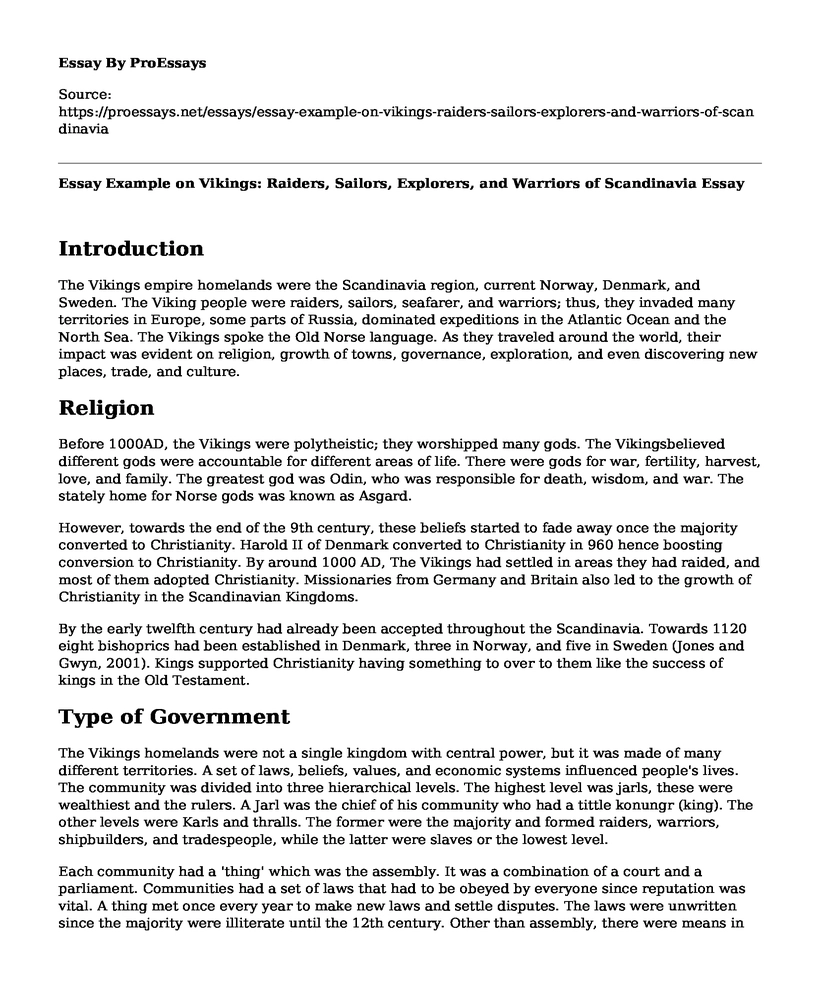Introduction
The Vikings empire homelands were the Scandinavia region, current Norway, Denmark, and Sweden. The Viking people were raiders, sailors, seafarer, and warriors; thus, they invaded many territories in Europe, some parts of Russia, dominated expeditions in the Atlantic Ocean and the North Sea. The Vikings spoke the Old Norse language. As they traveled around the world, their impact was evident on religion, growth of towns, governance, exploration, and even discovering new places, trade, and culture.
Religion
Before 1000AD, the Vikings were polytheistic; they worshipped many gods. The Vikingsbelieved different gods were accountable for different areas of life. There were gods for war, fertility, harvest, love, and family. The greatest god was Odin, who was responsible for death, wisdom, and war. The stately home for Norse gods was known as Asgard.
However, towards the end of the 9th century, these beliefs started to fade away once the majority converted to Christianity. Harold II of Denmark converted to Christianity in 960 hence boosting conversion to Christianity. By around 1000 AD, The Vikings had settled in areas they had raided, and most of them adopted Christianity. Missionaries from Germany and Britain also led to the growth of Christianity in the Scandinavian Kingdoms.
By the early twelfth century had already been accepted throughout the Scandinavia. Towards 1120 eight bishoprics had been established in Denmark, three in Norway, and five in Sweden (Jones and Gwyn, 2001). Kings supported Christianity having something to over to them like the success of kings in the Old Testament.
Type of Government
The Vikings homelands were not a single kingdom with central power, but it was made of many different territories. A set of laws, beliefs, values, and economic systems influenced people's lives. The community was divided into three hierarchical levels. The highest level was jarls, these were wealthiest and the rulers. A Jarl was the chief of his community who had a tittle konungr (king). The other levels were Karls and thralls. The former were the majority and formed raiders, warriors, shipbuilders, and tradespeople, while the latter were slaves or the lowest level.
Each community had a 'thing' which was the assembly. It was a combination of a court and a parliament. Communities had a set of laws that had to be obeyed by everyone since reputation was vital. A thing met once every year to make new laws and settle disputes. The laws were unwritten since the majority were illiterate until the 12th century. Other than assembly, there were means in place for resolving disputes (Sharpe and John, 2002). With the rise of Christianity, there was shifting from chieftains to more powerful kings with military and commanding large pieces of land.
Exploration
The Vikings traveled long distances both over land and sea .890 and 986; they discovered Iceland and Greenland, respectively. By 930, about fifty thousand Vikings were living in Iceland. Around 1000AD Lief Ericson, a Viking reached Canada and lived till 1020. They discovered or raided many places, which include: Faeroes, Orkney, Hebrides, Baffin Island, Russia, Europe, and North America.
When they invaded places, they found new cities and states like Kyiv, Novgorod, and Spitsbergen in 1194. Harold III Haardrande, in 1050 saw the modern city of Oslo.
Culture
Scandinavians were craftspeople, poets, and musicians. They made everyday weapons and items and produced luxury products like gold and silver jewelry. Jewelry mostly used symbols from their myths and religion. They also practiced shipbuilding and wood carving. Ornate carving on the prow of the Oseberg burial ship survives to date.
Conclusion
The impact of the Vikings civilization in the Middle Ages (1000-1300 AD) is evident across places raided or founded by the Scandinavians. Their religion, weakened religious beliefs of England, Scotland, Russia and ended Celtic Christianity in Ireland. With enough contact with raided regions, they abandoned their polytheistic religion for Christianity. The Vikings also adopted monarchical government, and their kings S led England between Sweyn Forkbeard 1013-1014, Canute 1016-1035, Harefoot, and Hardicanute upto1042. They created trading and voyage roots. Scandinavian traces language to Scotland and North Ireland to date.
Works Cited
Jones, Gwyn. A History of the Vikings. Oxford University Press, USA, 2001.
Sharpe, John C. "The Viking expansion| Climate, population, plunder." (2002).
Cite this page
Essay Example on Vikings: Raiders, Sailors, Explorers, and Warriors of Scandinavia. (2023, Jul 21). Retrieved from https://proessays.net/essays/essay-example-on-vikings-raiders-sailors-explorers-and-warriors-of-scandinavia
If you are the original author of this essay and no longer wish to have it published on the ProEssays website, please click below to request its removal:
- Race During the Industrial Revolution Essay
- Factors that Caused the Chicago Race Riot of 1919 Essay
- Essay Sample on Cold War Ideology: US vs. USSR 1965-1977
- Mum Bett: The African Woman Who Stole Freedom - Essay Sample
- The Berlin Wall: Symbol of the Iron Curtain Divide - Essay Sample
- Essay Example on Pacification in USA Military History: A Three-Part Approach
- The Man of Magnitude: Abraham Lincoln's Journey to Abolishing Slavery and Shaping American History







